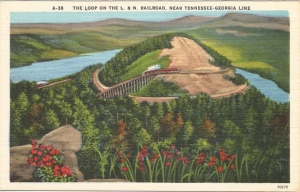I don’t have the foggiest where this is and neither does my buddy, who knows a thing or two about tipples. Since this was in the early 60s, over 50 years ago…it’s probably long gone by now.
There are a few thin clues to where it may have been: The Unknown Collector put his acquisition date as April 18, 1963 (that was a Thursday, I looked it up). The photographer was C. H. Ruth, who took chromes like this around the area, generally for Haynes Publishing, in the 60s. This one, though was published by “Mountaineer Post Card Service, Chilhowie, Va.”. Printed by Dexter in West Nyack, N.Y.
The hopper just visible under the front tipple is marked L&N.




























